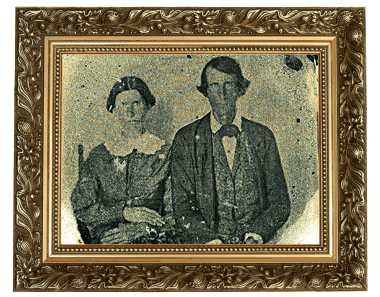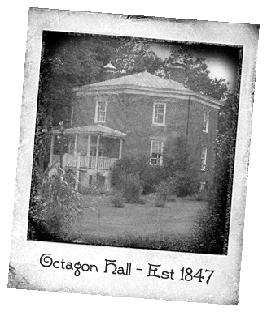


In 1847, Andrew Jackson Caldwell laid out the
foundation for his new family home. With a desire
for distinction, his home would not be a simple
structure with four walls like so many others, but
an eight sided edifice unique to the region.
Completed in 1859, it would soon become a
landmark in the south-central Kentucky area.
Built for his growing family and as a headquarters
for the plantation, it was occupied by the Caldwell
family even after Andrew's death in 1866. His
widow, Harriet, lived in the Octagon Hall until
selling the house in 1918 to Doctor Miles Williams,
an osteopath from Nashville, Tennessee.
Dr. Williams moved from Nashville and made the
Octagon Hall his residence until his death in
1954. At that time, the Octagon Hall was made
rental property by his heirs.
The Octagon Hall remained rental property until
The Octagon Hall Foundation was formed and
obtained the building in 2001. Dedicated to the
restoration and preservation of the only
eight-sided house in Kentucky, The Octagon Hall
Foundation is furthering the efforts to save the
past for the future.
foundation for his new family home. With a desire
for distinction, his home would not be a simple
structure with four walls like so many others, but
an eight sided edifice unique to the region.
Completed in 1859, it would soon become a
landmark in the south-central Kentucky area.
Built for his growing family and as a headquarters
for the plantation, it was occupied by the Caldwell
family even after Andrew's death in 1866. His
widow, Harriet, lived in the Octagon Hall until
selling the house in 1918 to Doctor Miles Williams,
an osteopath from Nashville, Tennessee.
Dr. Williams moved from Nashville and made the
Octagon Hall his residence until his death in
1954. At that time, the Octagon Hall was made
rental property by his heirs.
The Octagon Hall remained rental property until
The Octagon Hall Foundation was formed and
obtained the building in 2001. Dedicated to the
restoration and preservation of the only
eight-sided house in Kentucky, The Octagon Hall
Foundation is furthering the efforts to save the
past for the future.
| Andrew Jackson Caldwell and Harriet Morton Caldwell |

| The Civil War Years |
Mr. Caldwell, a very active pro-Confederate, finished building his home in 1859 just prior to the
Civil War. His brother was a Colonel in the Confederate Army. And because the house was on 31-
W or historically known as the Nashville Road, it was a local landmark. The Confederate Army
evacuated Bowling Green, which was the Confederate capitol of the state of Kentucky, on
February 13, 1862. They camped here the first night and in our best estimation from the military
record, somewhere between eight to ten thousand men camped on the grounds. The officers
probably stayed in the house overnight, which would have been very common. Because of his
Confederate leanings, of course, the Union army came shortly in pursuit of the Confederate army.
Apparently, the Union Army was really not in any hurry to confront the Confederate forces. They
waited for two days before arriving at the Octagon Hall.
They really mistreated the family. From the details that were related to a granddaughter, they
killed all their cattle. In fact, they even killed Mrs. Caldwell’s favorite milk cow, “Old Spot”. They ate
everything in sight. The facts were never related about what they did to the family as well as to the
slave women and children. They took the cattle carcasses and threw them into the wells so that
the water would be contaminated forcing the family to get their water elsewhere. They threatened
to burn them down (their property). Mr. Caldwell had enough brass to basically call their bluff and
say “ go right ahead, my brother just left and he'll come back looking for ya”. So, they may have
had the fear of the Lord put into them.
Needless to say, the Union army didn't burn the house.
Along that same line, Simpson County was occupied very quickly by the Union army, as the
Confederates went into Tennessee and on down into Shiloh. They knew that he was very pro-
Confederate and I'm sure they harassed him quite a bit. They would always sneak in to see if he
was hiding any Confederate soldiers, which he did very often. If they were wounded, hiding,
separated from their commands, needed food, whatever the case may be, if they could make it to
the house he would hide them and assist them in any way possible. It was reported that when he
heard of Union wagon trains traveling on Nashville Road, he would have the slaves plow the road
to create ruts and holes in order to harass the troop movements.
The Union army was aware of his actions and they came searching the property at all hours. They
would drop in out of nowhere in the middle of the night and just see if they could catch somebody
especially if a guerrilla attack had occurred.
The house had enough little hiding places they could stick them in different places. The union
forces weren't stupid or untrained. If they suspected that someone was hiding, they'd take the
property apart to try to find them.
The house originally had a cupola, which was used for part of the airflow. It was hit by lightning in
1916 and burned and never replaced. They just repaired the roof. Mr. Caldwell would keep his
beehives in the cupola. According to the journal that the granddaughter shared, they would put
the soldiers in a bee suit and put them up with the bees. So, whenever the Union soldiers would
open the trap door to go into the cupola, the bees would be swarming around and they would not
go on in and they'd back out quickly and not search the area. We can see just a portion of his
wiliness.
A little hiding place was discovered up under the front steps. While cleaning some brick, Billy Byrd
noticed a section that didn't have any mortar. He took the brick out and discovered a crawlspace
up under the huge stone front steps.
Apparently, what they would do was take the brick out, crawl up in there and set the brick back in
without mortar and that would give the impression of a wall. He used a metal detector and found
some buttons and .36 caliber bullets under the steps.
The house was used throughout the war as a sanctuary and hospital.
Civil War. His brother was a Colonel in the Confederate Army. And because the house was on 31-
W or historically known as the Nashville Road, it was a local landmark. The Confederate Army
evacuated Bowling Green, which was the Confederate capitol of the state of Kentucky, on
February 13, 1862. They camped here the first night and in our best estimation from the military
record, somewhere between eight to ten thousand men camped on the grounds. The officers
probably stayed in the house overnight, which would have been very common. Because of his
Confederate leanings, of course, the Union army came shortly in pursuit of the Confederate army.
Apparently, the Union Army was really not in any hurry to confront the Confederate forces. They
waited for two days before arriving at the Octagon Hall.
They really mistreated the family. From the details that were related to a granddaughter, they
killed all their cattle. In fact, they even killed Mrs. Caldwell’s favorite milk cow, “Old Spot”. They ate
everything in sight. The facts were never related about what they did to the family as well as to the
slave women and children. They took the cattle carcasses and threw them into the wells so that
the water would be contaminated forcing the family to get their water elsewhere. They threatened
to burn them down (their property). Mr. Caldwell had enough brass to basically call their bluff and
say “ go right ahead, my brother just left and he'll come back looking for ya”. So, they may have
had the fear of the Lord put into them.
Needless to say, the Union army didn't burn the house.
Along that same line, Simpson County was occupied very quickly by the Union army, as the
Confederates went into Tennessee and on down into Shiloh. They knew that he was very pro-
Confederate and I'm sure they harassed him quite a bit. They would always sneak in to see if he
was hiding any Confederate soldiers, which he did very often. If they were wounded, hiding,
separated from their commands, needed food, whatever the case may be, if they could make it to
the house he would hide them and assist them in any way possible. It was reported that when he
heard of Union wagon trains traveling on Nashville Road, he would have the slaves plow the road
to create ruts and holes in order to harass the troop movements.
The Union army was aware of his actions and they came searching the property at all hours. They
would drop in out of nowhere in the middle of the night and just see if they could catch somebody
especially if a guerrilla attack had occurred.
The house had enough little hiding places they could stick them in different places. The union
forces weren't stupid or untrained. If they suspected that someone was hiding, they'd take the
property apart to try to find them.
The house originally had a cupola, which was used for part of the airflow. It was hit by lightning in
1916 and burned and never replaced. They just repaired the roof. Mr. Caldwell would keep his
beehives in the cupola. According to the journal that the granddaughter shared, they would put
the soldiers in a bee suit and put them up with the bees. So, whenever the Union soldiers would
open the trap door to go into the cupola, the bees would be swarming around and they would not
go on in and they'd back out quickly and not search the area. We can see just a portion of his
wiliness.
A little hiding place was discovered up under the front steps. While cleaning some brick, Billy Byrd
noticed a section that didn't have any mortar. He took the brick out and discovered a crawlspace
up under the huge stone front steps.
Apparently, what they would do was take the brick out, crawl up in there and set the brick back in
without mortar and that would give the impression of a wall. He used a metal detector and found
some buttons and .36 caliber bullets under the steps.
The house was used throughout the war as a sanctuary and hospital.

©2011 Octagon Hall, Franklin, KY. All Rights Reserved - (270).791.0071
| Website by: |

AMAZING FACT
All of the bricks used to build the Octagon
Hall were hand made on the Plantation from
clay and materials from the property.
All of the bricks used to build the Octagon
Hall were hand made on the Plantation from
clay and materials from the property.
HISTORY
Connect:
